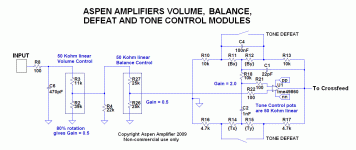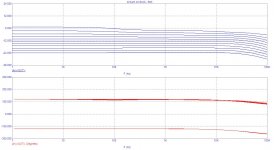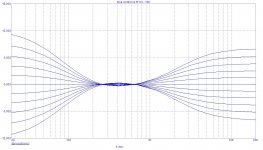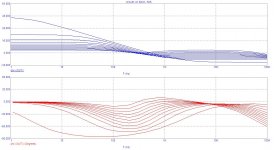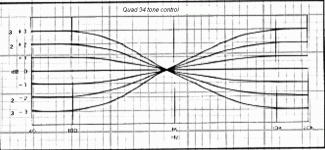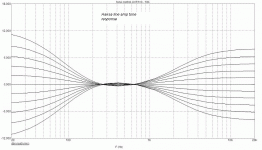Member
Joined 2009
Paid Member
Bigun, I'd be happy to see your ideas if you don't believe you can do much with them. But if you had a strong sense of intuition when making them, I would be careful. This sense of intuition was my gateway into electronics and in my opinion your intuition should be kept to yourself - it means that you have very special insights, for whatever reason, into that specific circuit more than most people. It may just be a funny feeling now, but later you might "see the light" after learning more.
You describe it very well, this is how I feel a lot innovation comes to bear fruit.
Michael,
They look fine. 200V, 100mA, Cob 1.9-2.3pF, good beta linearity, they look good.
The 3423 however is specifically designed for audio, where these devices you suggest are used for high definition CR tubes on TVs and monitors. I have used video devices in audio (BF469/470, 2SC1819) and they work well, but I suspect that the greater beta linearity of the audio variant and it's very flat Cob from 0.5 to 100V Vce (1.8 to 4pF) might be the clincher.
Cheers,
Hugh
Hi Hugh,
just want to say thanks for your input!
I just wish Toshiba could show us some SOA curves (ASO as the Japanese prefer to call it I think) as Sanyo do, at least I'm missing those curves in my Toshiba data sheet dated 2001-10-29.
While Toshiba might be a bit more linear then the Sanyos have a little advantage in the higher current capability in case that is the need.
Cheers Michael
Michael,
It's a pleasure, thank you for dropping by!
Folks,
Next instalment of the Headphone Amp, which I've sadly neglected the past week, my apologies. This incorporates the volume and balance controls, the Baxandall non-inverting tone control module with IC at the heart, and the tone defeat switches.
I'm indebted to Paul Bysouth, a clever Melburnian engineer whose input has been extremely helpful. Thanks Paul!
Next and last to address is crossfeed, which I will implement before the power amp rather than after.
Comment invited,
Cheers,
Hugh
It's a pleasure, thank you for dropping by!
Folks,
Next instalment of the Headphone Amp, which I've sadly neglected the past week, my apologies. This incorporates the volume and balance controls, the Baxandall non-inverting tone control module with IC at the heart, and the tone defeat switches.
I'm indebted to Paul Bysouth, a clever Melburnian engineer whose input has been extremely helpful. Thanks Paul!
Next and last to address is crossfeed, which I will implement before the power amp rather than after.
Comment invited,
Cheers,
Hugh
Attachments
Last edited:
Hello Hugh
I know that you are very buzy with the assembly of the Soraya 2009, so it's very normal that you have less time for the Haksa.
Nice tone control, good thing to ad the C2 local HF feedback.
I don't have the LME49860, but for good high speed op-amp I have the LM4562, LM49740, THS4031, OPA637 and AD825
If I remember correctly what I've read, the LME49860 do have a bit softer high and are less prone to oscillate than the the LM4562.
Thank
Bye
Gaetan
I know that you are very buzy with the assembly of the Soraya 2009, so it's very normal that you have less time for the Haksa.
Nice tone control, good thing to ad the C2 local HF feedback.
I don't have the LME49860, but for good high speed op-amp I have the LM4562, LM49740, THS4031, OPA637 and AD825
If I remember correctly what I've read, the LME49860 do have a bit softer high and are less prone to oscillate than the the LM4562.
Thank
Bye
Gaetan
Last edited:
This is the response of the new schematic posted above but turning the pots in opposite direction. Sort of tilt I guess.
Not something I am used to, but maybe you guys have built and listened to it, it may be the next best thing since sliced bread.
Not something I am used to, but maybe you guys have built and listened to it, it may be the next best thing since sliced bread.
Attachments
I have looked again at the tone control section, and here are the results:
Output for 1V45p input (0dB) into 10K load:
Controls FLAT (midpoint on linear pots) Gain 6dB, -0.1dB points at 20Hz and 1MHz
BASS BOOST: +6.2dB at 50Hz (-31 degrees phase shift at 64Hz)
BASS CUT: -4dB at 50Hz (+21 degrees phase shift at 10Hz)
TREBLE BOOST: +5.9dB at 10KHz (+35 degrees phase shift at 10KHz)
TREBLE CUT: -4.1dB at 10KHz ( -15.5 degrees phase shift at 3.9KHz)
DEFEAT ENABLED 6dB gain with -1dB point at 12Hz
Phase shift +10 degrees at 40Hz and -0.15 degrees at 100KHz
This is not graphical, but measured straight off the simulation (LTSpice). There is not much boost and cut, certainly, but it is functioning as it should.
I had not intended to put in a tone control in the original circuit, but this is a good one though the effects are not pronounced. It is a non-inverting tone control too, which is an advantage. I will continue investigating.
Hugh
Output for 1V45p input (0dB) into 10K load:
Controls FLAT (midpoint on linear pots) Gain 6dB, -0.1dB points at 20Hz and 1MHz
BASS BOOST: +6.2dB at 50Hz (-31 degrees phase shift at 64Hz)
BASS CUT: -4dB at 50Hz (+21 degrees phase shift at 10Hz)
TREBLE BOOST: +5.9dB at 10KHz (+35 degrees phase shift at 10KHz)
TREBLE CUT: -4.1dB at 10KHz ( -15.5 degrees phase shift at 3.9KHz)
DEFEAT ENABLED 6dB gain with -1dB point at 12Hz
Phase shift +10 degrees at 40Hz and -0.15 degrees at 100KHz
This is not graphical, but measured straight off the simulation (LTSpice). There is not much boost and cut, certainly, but it is functioning as it should.
I had not intended to put in a tone control in the original circuit, but this is a good one though the effects are not pronounced. It is a non-inverting tone control too, which is an advantage. I will continue investigating.
Hugh
High Hugh, there is no problem at all with phase shift. There is not a filter in the world that does not produce phase shift. I have no real concern with the tone control, just that it modelled in a way that I was not accustomed too.
Quad did their tilt control and people loved it. If it sounds good then it must be good.
Peter Baxandal probably had the same response when he first introduced his bass and treble control.
Nico
Quad did their tilt control and people loved it. If it sounds good then it must be good.
Peter Baxandal probably had the same response when he first introduced his bass and treble control.
Nico
Hello
Looking at the Quad tilt control (the first image), it have only -3 and +3 db of cut and boost.
So the Haksa tone amp (the second image), do have more db of cut and boost.
The first look at the Haksa tone amp curves was a surprise for me but the Haksa tone do have quite enough db control for our usages.
And both Quad tilt and Haksa tone curves are more gradual than the Baxandal tone curve.
Bye
Gaetan
Looking at the Quad tilt control (the first image), it have only -3 and +3 db of cut and boost.
So the Haksa tone amp (the second image), do have more db of cut and boost.
The first look at the Haksa tone amp curves was a surprise for me but the Haksa tone do have quite enough db control for our usages.
And both Quad tilt and Haksa tone curves are more gradual than the Baxandal tone curve.
Bye
Gaetan
Attachments
Last edited:
Thanks Gaetan!
Very nice graph, you did that in Tina?
When you gun for more cut/boost with the circuit used in the HAKSA, when controls are flat there are serious discrepancies in the FR. With the values chosen, there is no such effect, but cut/boost are limited, also by the non-inverting issue, which is not usual for a conventional Baxandall and I wanted to avoid. Without the small 22pF cap on the fb loop of the opamp, there is serious gain peaking, but with it, all is well.
Merci,
Hugh
Very nice graph, you did that in Tina?
When you gun for more cut/boost with the circuit used in the HAKSA, when controls are flat there are serious discrepancies in the FR. With the values chosen, there is no such effect, but cut/boost are limited, also by the non-inverting issue, which is not usual for a conventional Baxandall and I wanted to avoid. Without the small 22pF cap on the fb loop of the opamp, there is serious gain peaking, but with it, all is well.
Merci,
Hugh
Geatan,
your HAWKS response curve is not representative of a tone control using a non-inverting gain stage.
Firstly the non-inverting gain stage gain ratios will not give you equal boost and cut, moreover as you adjust the pots you will also create an output offset as you imbalance the inverted input with respect to the non-inverted input.
Furthermore you have two separate phase responses one for the high pass which is incidentally is around -180 deg and the low pass which is around +180 deg.
Please post the circuit that gave you the HAKSA response because simple arithmetic does not agree with Tina the ballerina.
The reason for choosing an inverted gain stage in particular to get the boost and cut ratios symmetrical around zero, one can precede it with another inverted stage if for some reason one can hear that the music is inverted, which is a little doubtful.
Kind regards
Nico
your HAWKS response curve is not representative of a tone control using a non-inverting gain stage.
Firstly the non-inverting gain stage gain ratios will not give you equal boost and cut, moreover as you adjust the pots you will also create an output offset as you imbalance the inverted input with respect to the non-inverted input.
Furthermore you have two separate phase responses one for the high pass which is incidentally is around -180 deg and the low pass which is around +180 deg.
Please post the circuit that gave you the HAKSA response because simple arithmetic does not agree with Tina the ballerina.
The reason for choosing an inverted gain stage in particular to get the boost and cut ratios symmetrical around zero, one can precede it with another inverted stage if for some reason one can hear that the music is inverted, which is a little doubtful.
Kind regards
Nico
Looks good to me Hugh. I can't imagine ever cranking the controls on a 'conventional' tone control through more than 50% of their range. And with headphones we are talking about fine tuning so 4 to 6 db should be just enough.
50% (or in the centre) should be representative of a flat response, but not in a non-inverting gain stage.
You probably meant 75%.
Last edited:
Geatan,
your HAWKS response curve is not representative of a tone control using a non-inverting gain stage.
Firstly the non-inverting gain stage gain ratios will not give you equal boost and cut, moreover as you adjust the pots you will also create an output offset as you imbalance the inverted input with respect to the non-inverted input.
Furthermore you have two separate phase responses one for the high pass which is incidentally is around -180 deg and the low pass which is around +180 deg.
Please post the circuit that gave you the HAKSA response because simple arithmetic does not agree with Tina the ballerina.
The reason for choosing an inverted gain stage in particular to get the boost and cut ratios symmetrical around zero, one can precede it with another inverted stage if for some reason one can hear that the music is inverted, which is a little doubtful.
Kind regards
Nico
Hello Nico
I have installed the Tina-TI simulator to replace my old Tina 4.15.
But the Tina-TI simulator are doing some free games, the FFT was very erronous lately, and now the response curve seem to have problems, so yesterday night I did post a question on the Tina forum. It's the second times that I need to uninstall and reinstall my Tina-Ti simulator.
Thank
Bye
Gaetan
- Home
- More Vendors...
- AKSA
- Aspen Headphone Amp
